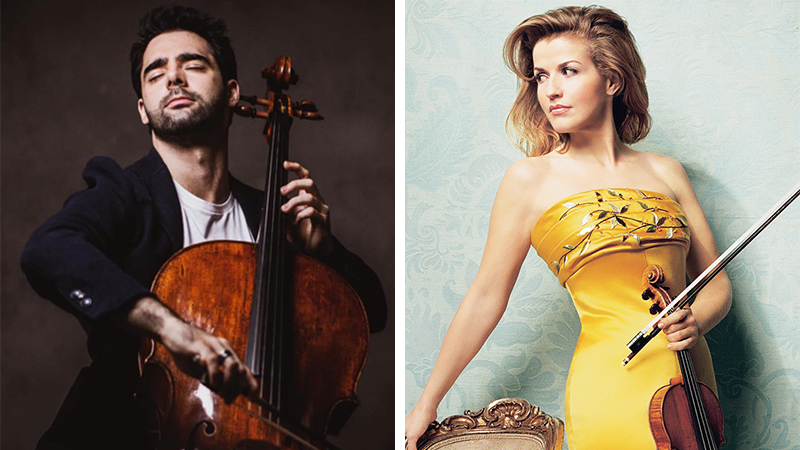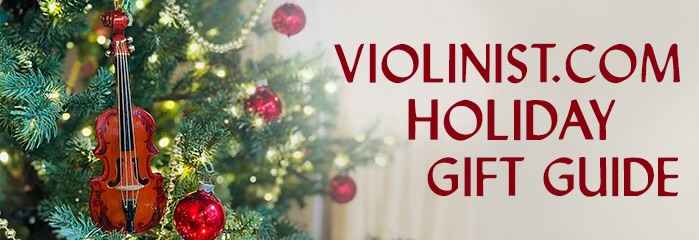REVIEW: Anne-Sophie Mutter and Pablo Ferrández Perform Brahms with LA Phil
The Brahms Double Concerto is a conversation, a collaboration, and at times even a conscious collision between two instruments: the violin and the cello. When two soloists perform it well, it is a little like watching two master actors play a convincing but enigmatic scene, where you don't quite know the relationship. Friends? Rivals? Lovers? Siblings?
On Saturday night violinist Anne-Sophie Mutter and cellist Pablo Ferrández explored the emotional range of this cello-violin drama in an energetic and whole-hearted performance with the Los Angeles Philharmonic and conductor Gustavo Dudamel, for a full house at Walt Disney Concert Hall. (This was one of three performances, the others were Friday night and Sunday afternoon.)

Cellist Pablo Ferrández and violinist Anne-Sophie Mutter.
Johannes Brahms wrote his Concerto for Violin, Cello and Orchestra in 1887, and over the centuries since the work has brought together many a cellist and violinist onstage, starting with dedicatee Joseph Joachim and cellist Robert Hausmann and including famous pairings such as Mstislav Rostropovich and David Oistrakh, Jascha Heifetz and Emanuel Feuermann, Nathan Milstein and Gregor Piatigorsky, Isaac Stern and Yo-Yo Ma, Joshua Bell and Steven Isserlis. Siblings have played it together - Christian Tetzlaff recently recorded it with his sister, Tanja Tetzlaff; brothers Renaud Capuçon and Gautier Capuçon have recorded it.
For this performance the pair was a veteran superstar and her protegé - their relationship began when Ferrández auditioned for Mutter about a decade ago, and he became a scholar of the Anne-Sophie Mutter Foundation. Born in Madrid, Ferrández studied at the Kronberg Academy and was a prizewinner of the XV International Tchaikovsky Competition.
Their first performance of the Brahms Double occurred just months after their first meeting. More recently, in January 2022 they created a recording - a live performance in Prague with the Czech Philharmonic under Manfred Honeck. (Mutter's other recording of the Brahms Double was in 1983 with cellist António Meneses and the Berlin Philharmonic, with Herbert von Karajan.)
On Saturday night they played with the familiarity and ease of well-versed musical partners, Mutter in a stunning yellow-gold dress with a sparkling bodice and wavy white flowers, and Ferrandez raised on a small podium.
The Brahms Double begins with a short orchestral introduction, then an opening statement from the cello - Ferrández's felt improvisatory, with much rubato. Ferrández plays on the 1689 "Archinto" Stradivari cello (on loan from a member of the Stretton Society), and he milked the sound for maximum effect, rolling chords slowly, with physically dramatic gestures.
Mutter joined in, and there began a wide-ranging musical conversation: at times emphatic, at times gentle. A heated back-and-forth argument evaporated into a peaceful unison. When there was humor, they almost laughed. Together they were in agreement with the trajectory of this drama and the many details that animated each different episode.
Both also had an unwavering stage presence - true soloists, but perhaps I should say true "duetists," as neither overshadowed the other, unless the music called for it.
For its part the LA Phil played with tremendous energy - somehow the emphatic up-bows in all the strings during the first movement were particularly exciting. Dudamel was sensitive to the pair's sometimes quirky transitions and tempo changes.
The second movement starts in unison, and Mutter produced a beautiful sound with smooth playing high on the G string. They took turns trading the melody, looking at each other frequently and playing with a dynamic range that went far beyond loud and soft - it was in their very energy.
The third movement featured impressive synchronicity and a wild ride to the end. After, the audience gave the performers an enthusiastic standing ovation and three curtain calls.
Bruckner Symphony No. 1
The second half of the concert featured Anton Bruckner's Symphony No. 1 (in its 1891 revised form). It felt like a good pairing with the Brahms Double, with its sometimes-stormy personality. Interestingly Brahms and Bruckner share a common life fact: each was in his 40s before releasing a first symphony - Brahms was 43 and Bruckner was 42.
I suspect that the success of this symphony comes down to choices of tempo - getting the sometimes disparate ideas to connect and flow together. Dudamel does this exceptionally well under any circumstance, so it does not surprise me that in his hands, this piece (which is so seldom played) was enjoyable and worked well. The opening of the symphony sounds especially well-crafted and ahead of its time. A violinist myself, I could not help but notice how toilsome this piece seemed for the strings (not that they were showing it) - but I started feeling like I needed a back massage just watching the 52 minutes of their nearly non-stop playing!
A special shout-out to timpanist Joseph Pereira, the only percussionist on stage. His precision playing caught my attention for most of the fourth movement, as did his assortment of mallets - about 16 hanging from a stand in front of him, as well as another dozen off to the side. During the long applause afterwards, the audience gave him the biggest cheer.
You might also like:
- Review: Mahler 6 with Gustavo Dudamel and the LA Phil
- Violinist.com interview with Anne-Sophie Mutter: Brahms Sonatas (2010)
- Violinist.com interview with Anne-Sophie Mutter (2008)
* * *
Enjoying Violinist.com? Click here to sign up for our free, bi-weekly email newsletter. And if you've already signed up, please invite your friends! Thank you.Tweet
Replies
This article has been archived and is no longer accepting comments.
Violinist.com is made possible by...
Dimitri Musafia, Master Maker of Violin and Viola Cases
International Violin Competition of Indianapolis
Violinist.com Holiday Gift Guide
Johnson String Instrument/Carriage House Violins
Subscribe
Laurie's Books
Discover the best of Violinist.com in these collections of editor Laurie Niles' exclusive interviews.

Violinist.com Interviews Volume 1, with introduction by Hilary Hahn

Violinist.com Interviews Volume 2, with introduction by Rachel Barton Pine







